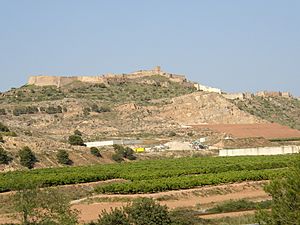Siege of Saguntum facts for kids
Quick facts for kids Siege of Saguntum |
|||||||
|---|---|---|---|---|---|---|---|
| Part of the Second Punic War | |||||||
 Medieval castle of Saguntum |
|||||||
|
|||||||
| Belligerents | |||||||
| Saguntines | |||||||
| Commanders and leaders | |||||||
| Hannibal (WIA) Maharbal |
Unknown | ||||||
| Strength | |||||||
| Unknown | Unknown | ||||||
| Casualties and losses | |||||||
| Heavy | Nearly the whole fighting force was killed A number of civilian casualties |
||||||
The Siege of Saguntum was a big battle that happened in 219 BC. It was fought between the Carthaginians and the people of Saguntum, a city in what is now Spain. This battle is super important because it started one of the biggest wars in ancient times: the Second Punic War.
Contents
Why Hannibal Attacked Saguntum
Hannibal became the main leader of the Carthaginian army in Spain in 221 BC. He was only 26 years old. For two years, he carefully planned how to make Carthage more powerful in the Mediterranean Sea.
The Romans knew Hannibal was getting ready, but they didn't stop him. They were busy fighting other groups. This meant the Romans didn't react when Hannibal started attacking Saguntum.
Capturing Saguntum was a key part of Hannibal's plan. The city was very strong and well-protected. Leaving it in enemy hands would have been a bad idea. Hannibal also needed money to pay his soldiers, who were mostly from Africa and Spain. This money could also help him deal with his political rivals in Carthage.
The Siege of Saguntum
During Hannibal's attack, his army faced strong defenses and brave fighters from Saguntum. Hannibal's troops slowly broke through the city's walls. Hannibal himself was badly hurt in the leg by a spear. Fighting stopped for a few weeks while he got better.
The people of Saguntum asked Rome for help, but no help arrived. In 218 BC, after eight months of fighting, Saguntum's last defenses were finally broken. Hannibal offered to let the people live if they left the city without weapons, each with two pieces of clothing.
The Saguntines refused this offer. Instead, they tried to destroy their own valuable things. Because of this, many adults in the city lost their lives.
This event officially started the Second Punic War. Hannibal now had a strong base in Saguntum. From there, he could get food and more soldiers for his army.
What Happened Next
After the siege, Hannibal tried to get support from the Carthaginian Senate. The Senate, which had some members who favored Rome, often disagreed with Hannibal's aggressive war plans. They never fully supported him, even when he was very close to winning the war against Rome.
However, after Saguntum, Hannibal did get some limited support. This allowed him to move to New Carthage. There, he gathered his soldiers and told them about his big plans. Hannibal then went on a short religious trip. After that, he began his famous march toward the Pyrenees mountains, then the Alps, and finally toward Rome itself. The next part of the war saw amazing Carthaginian victories at Trebia, Lake Trasimene, and the Battle of Cannae.
Legacy of the Siege
Hundreds of years later, around the end of the 1st century AD, a Roman writer named Silius Italicus wrote a long poem called Punica. This poem described the Siege of Saguntum in great detail. It featured several brave Saguntine leaders and even a Libyan warrior princess fighting for Carthage. However, most historians don't see this poem as a completely accurate historical source.
In 1727, an English writer named Philip Frowde wrote a play called The Fall of Saguntum. This play was based on Silius's poem.
Even a modern band, Ex Deo, has a song about the event. It's called "Hispania (The Siege of Saguntum)" and is on their album The Immortal Wars.
See also
 In Spanish: Sitio de Sagunto para niños
In Spanish: Sitio de Sagunto para niños
- Alorcus

